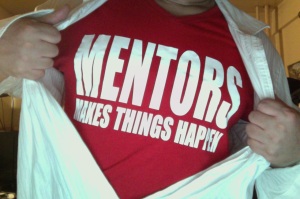This past Thursday I attended my first class at Teachers College, and let me tell you, it was quite the experience. I learned so much in 100 minutes of class time that I needed two days to fully process it all…and that was from one class! I’m gonna need a bigger brain.
I had thought that the class I attended, Mathematics for Childhood Education, would be a long lecture about how we were to manipulate the brains of our little charges so that they could better grasp the concepts we were about to cram into their heads. That notion was shattered within the first ten minutes of the class—it was our brains that would be manipulated.
Our preconceived notions about how children feel and think were challenged when the instructor gave us a “do now” exercise. That’s right, a quiz…on Day One!
“Carol bought some items at the deli. All the items she bought were the same price, and she bought as many of the items as the price of the items in cents (for example, if items costs two cents each, she bought two of them for a total of $0.04. Or if she chose items costing eight cents, she would have bought eight of them.) Her bill was $2.25. How many items did she buy?”
After giving the class a few minutes to do the word problem, the instructor asked how we felt about having been given the test. Not surprisingly, the class reported various levels of anxiety.
Our first lesson: Kids are anxious about taking tests, just as we were at that moment.
When the instructor asked how we arrived at the solution to the problem, most gave algebraic formulas, the deconstruction of square numbers or other methods gained through higher learning in order to arrive at the answer. One answer brought a wide smile to the instructor’s face: a student simply counted up from one until she reached the answer (15 items at 15 cents each).
Our second lesson: Kids don’t use complicated equations to solve problems.
Later, we were broken up into groups, with each group solving a different word problem. Rather than simply having one person in the group come up with the answer, the group worked together, comparing strategies on how they arrived at the answer. In most cases, the simplest strategy made the most sense. Other methods were used to check and double-check answers. And since the group had to explain how it arrived at the answer to the rest of the class, the simplest way proved to be the easiest to communicate. In this manner, the group worked together to find the solution, with each member of the group contributing either a different strategy or a concern about the outcome.
Our third lesson: Kids work best when they share information in order to resolve a problem.
As the class continued, we all seemed to pick up on the main theme of the session: children learn the way children learn, not the way adults learn, so we cannot teach them as if we are teaching adults. This brought me back to the “Growing Down” article I wrote here awhile back; as prospective educators, we cannot expect kids to grasp concepts that we ourselves learned (and in some cases, re-learned) years past their grade level. It is up to us to understand their thought processes and problem-solving abilities.
For me, that was the key in solving many of the homework problems we were given. Rather than using algebra immediately to discern whether a sequence of numbers were arithmetic or geometric, I simply counted the differences between the numbers in each example. The algebra came to be understood once I had a grasp of how the differences could be put into a formula. In other words, there was a progression to how I learned..
I’ve been shown how education has changed drastically from the days when I was in elementary school (think pre-disco!). I am also glad to see my assumptions on how we should reach children was correct; that we should reach them on their level, so that they can relate to the material, even if it gives them a little discomfort. We should not sell them short—they can work together to solve problems just as we adults can (maybe better than we can, I think!).
One class. All this came out of just one class. I have three other classes, and nearly four months to go before this semester ends. If you see someone’s head spontaneously explode on a YouTube video somewhere, it will probably be mine.






